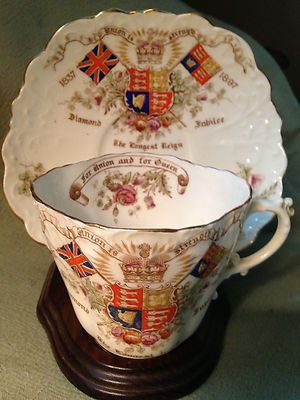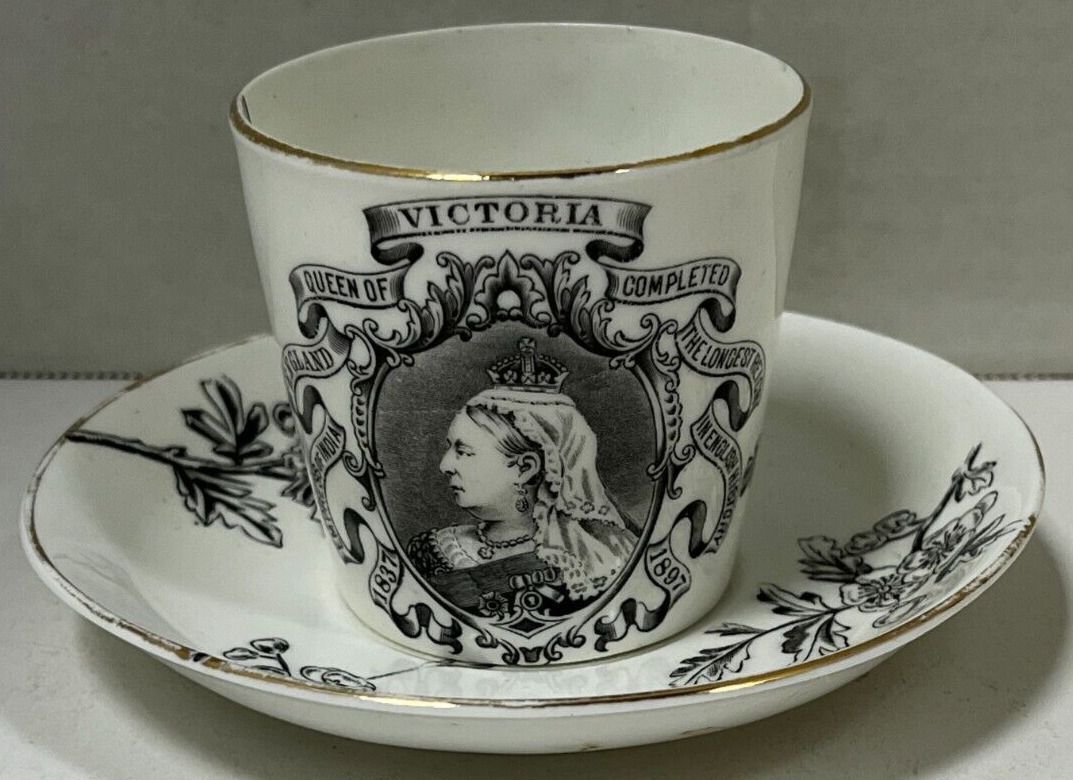Antique Tea Cups Value: How to Get the Value of Old Tea Cups and Saucers
An antique tea cup is a beautiful thing to behold – typically ornate or simply elegant, these items are a highlight in any kitchen or displayed in a cabinet. These delightful items are highly collectible and affordable compared to many antique categories, which makes them a great addition to any collection.
Designs can vary greatly from delicate, plain white bone porcelain to elaborately painted oriental designs depicting entire scenes. Antique tea cups are often mistaken for antique coffee cups which tend to be taller and have the handles placed lower down.
Perhaps you have inherited some antique tea cups, or found a great set at a yard sale? Maybe you want to start a collection of your own, and are looking for tips on a great purchase? You have come to the right place!
Today, we will talk you through identifying, valuing and buying antique teacups. We will help you to evaluate a tea cup and pick out some of the most common, stunning examples from China, Japan, Germany, France and England.
Brief History Of Antique Tea Cups
When it comes to identifying and valuing antique tea cups, it can be very useful to find out a little more about their history and provenance.
At first, tea was consumed in China in specialized tea bowls rather than the typical tea cups we think of today. In the 18th century, porcelain reached Europe and tea bowls were set upon dishes (or saucers) to prevent damage to furniture.

By the mid 18th century, it became standard to drink from cups with handles which were placed upon saucers. The first company to manufacture this crafty design was a German company called Meissen. Soon, Chinese companies followed suit, and a whole range of beautiful tea cups were produced in the following decades.

From around 1740, a full tea service became popular. This usually included a full set of teacups, saucers, coffee cups, a milk jug, a “slop” bowl (for tea leaves!), a sugar bowl, and of course a tea pot. It is rare to find a complete antique tea service nowadays, but this makes them incredibly valuable!

Throughout the ages there have been intriguing and beautiful tea cups designs from the Victorian moustache cup (featuring a bridge running along the inside of the cup to stop the tea from ruining a gentleman’s moustache!) to the double handled caudles (hot chocolate cups).

Identifying Antique Tea Cups
First it is important to note that an antique is classed as an item which was made more than 100 years ago. Items made within 20 and 100 years ago are classed as vintage.
There are some key steps to take in the identification of antique tea cups, and you may have to perform some extensive research to find the typical value of your tea cups. Let’s get to it…
Maker Or Manufacturer
Usually on the underside of the tea cup there will be some kind of maker’s mark. This could be an image, logo, word, numbers, letters, or a combination of these.
Some key manufacturers to look out for include:
- Royal Doulton – one of the top tea cups manufacturers for over 200 years! Some of their designs are world renowned. Their mark usually contains a seal, the company name, and a crown and lion
- Limoges – this is in fact a group of tea cup manufacturers which originated in Limoges in France. It can be a complex task to find out the exact provenance of a Limoges tea cup as there is a whole range of manufacturers responsible! Try this guide to help you out.
- Wedgwood – the Wedgwood mark usually contains an urn and the company name. This company is popular for matte colored china called jasperware. Their patterns are usually very distinctive.
- Meissen – this manufacturer is perhaps the most famous which comes from Germany and dates back to the 1700s! The Meissen maker’s mark usually includes two crossed swords or possibly an oval.
- Spode – this company is particularly known for transferware of blue and white patterns. The manufacturer has been around for centuries and is one of the biggest tea cup manufacturers from England.
Sometimes the base of the cup will simply say “made in China”, “made in Japan”, or “made in Germany”. Don’t despair! This can still be a vital clue when searching for the provenance of the cup. The bigger brands, however, will almost always include a maker’s mark on the base of the cup. So a lack of mark may indicate a less famous brand or a more modern tea cup.




Pattern
Once you have established the maker, it is time to identify the pattern. The pattern can dictate the value, and often has a dedicated pattern name which will help you in your valuation efforts. Some key patterns which are valuable to collectors include:
- Royal Doulton: Carlyle, Brambly Hedge, Coronet.
- Limoges: Wild Rose (below), FXL5, no pattern (hand-painted details or gilding instead of a printed pattern)
- Haviland (a Limoges manufacturer): Rosalinde, Chambord, Frontenac.
- Wedgwood: Patrician, Cream Color on Lavender (jasperware), Columbia White.
- Meissen: Blue Onion (below), Rose Pink, Scattered Flowers.
Try searching for a similar pattern online to help you in your identification quest. Use keywords pertaining to the features in the pattern such as “roses”, “vine leaves”, or “gilding”.
Items In The Set
If you have a set of tea cups and other items within a tea service, this may help with identification. How many cups do you have? Are they tea cups or coffee cups? Are there saucers? Do you have the original sugar bowl or tea pot?
The number of items in a set, in other words the more complete the tea service, the higher the value. Some tea services were produced with a particular number of items or with specific additions such as a sugar bowl with a lid.
Valuing Antique Tea Cups
When it comes to valuing antique tea cups it is fairly easy to establish a value yourself. Take a careful look at your tea cup, make sure you identify it positively, and start searching for other similar items online.
Depending on the age, condition, rarity, manufacturer, pattern, and how complete your tea cup set is, the value can vary greatly. Some tea cups sell for only a few dollars while others can sell for $100 USD or more!
Condition
The condition of your tea cup is key to its value! Those in mint (perfect) condition, without any damage or wear can fetch a high price. Tea cups with worn decoration, chips, scratched glaze, cracks, and missing pieces will be worth much less.
Age
As a general rule, the older the tea cups, the greater the value. More modern tea cups, and those with patterns which are still manufactured today are worth very little. Tea cups which were made more than 200 years ago are especially valuable.
Number Of Items
The more complete the tea service, the higher price it will fetch! Complete antique tea services are worth a great deal. Even incomplete sets, or just the tea cups and saucers can be very valuable.
Manufacturer And Pattern
The manufacturers we have listed above are among the most famous and well-respected tea cup manufacturers in the world. Hence, their tea cups are among the most valuable. Take time to research any marks you find on the base of the cup.
Likewise, certain patterns are more highly valued than others. Limited editions or those produced for special occasions tend to be more valuable. A prime example of this is Royal Albert china (below) or Albert Crown china. Thomas Wild and Co. manufactured special pieces in England from bone china to mark Queen Victoria’s 1897 Diamond Jubilee.



Some Examples of Queen Victoria's Diamond Jubilee Tea Cups
Appraisal
If you are stuck and you’d like a professional opinion it is a great idea to get an expert evaluation. You can try posting images of your mirror on antiques forums such as:
- TreasureNet What’s It Worth?
- or this active Subreddit forum called WhatsThisWorth.
Enthusiasts can often be very useful and love to help one another out. Try to include as much information as possible in your post so others can help you value your tea cups.
Contacting an antique tea cup expert is also an option. Try visiting your local antiques shop, or track down an expert online. You will have to pay for this type of professional valuation (also called appraisal), but it may pay off if the tea service is worth more than you realised, then you can sell it for more!
You can get a great idea of the price of your item by searching for similar items on auction sites including the antique cups and saucers section of eBay. Here, you can refine your search by material, color, and condition. You could also try searching for something similar in the collection of interesting auction items on sites like Love Antiques.
Antique Tea Cups Buying Guide
So you’ve decided you want to form you own antique tea cup collection, excellent decision! First of all, it is a good tip to formulate an idea of what you are interested in. Do you like a particular style of tea cup? Are you interested in rare items? Would you like a complete tea service?
Collectors often like to theme their collections, for example by color or type of pattern. This could be a good place to start. There are a few things to bear in mind when making a purchase.
Do Your Research
Make sure you are familiar with the key features of your desired tea cups, and any potential signs of a fake or a reproduction. If you are interested in a particular maker or manufacturer, be sure to research their maker’s mark.
Details, Details, Details
Details in listings are key! Whether you want to buy online or in person at an antiques fair, go for items which include a lot of details about the design, provenance, history and materials. Details about any damage are also key, and a good sign of an honest seller.
Don’t be afraid to ask the seller for more details such as extra close-ups if buying online, or a little more about the provenance of the tea cups if buying in person. Be aware, there is a lot of misinformation out there!
Check Reputable Auction Sites
We recommend checking eBay and Collectors Weekly for a range of interesting listings.
It’s worth keeping an eye out for yard sales and second hand shops – you can find many interesting items for very low prices in these places. It can be very satisfying to find a rare item for a low price – think of all the potential under-valued antique tea cups out there waiting for you!




